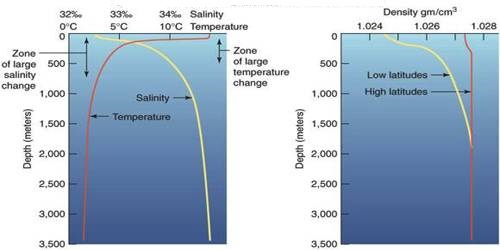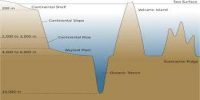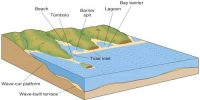Vertical Distribution of Salinity
Salinity changes with depth, but the way it changes depends upon the location of the sea. Salinity at the surface increases by the loss of water to ice or evaporation or decreased by the input of fresh waters, such as from the rivers. Salinity at depth is very much fixed because there is no way that water is ‘lost’, or the salt is ‘added’. There is a marked difference in the salinity of the surface zones and the deep zones of the oceans. The lower salinity water rests above the higher salinity dense water. Salinity, generally, increases with depth and there is a distinct zone called the halocline, where salinity increases sharply. Other factors being constant, increasing salinity of seawater causes its density to increase. High salinity seawater, generally, sinks below the lower salinity water. This leads to stratification by salinity.
The following characteristics of the vertical distribution of salinity may be stated:
- Salinity raises with rising depth in high latitudes i.e. there is the positive relationship between the amount of salinity and deepness because of denser water below.
- The trend of increase of salinity with increasing depths is confined to 200 fathoms from the surface in middle latitudes beyond which it decreases with increasing depths. Salinity is low at the surface at the equator due to high rainfall and transfer of water through equatorial currents but higher salinity is noted below the water surface.
- Maximum salinity is found in the upper layer of the oceanic water. Salinity decreases with increasing depth.















